实验3 类和对象_基础编程2
试验任务1:
button.hpp:
#pragma once #include <iostream> #include <string> using std::string; using std::cout; // 按钮类 class Button { public: Button(const string &text); string get_label() const; void click(); private: string label; }; Button::Button(const string &text): label{text} { } inline string Button::get_label() const { return label; } void Button::click() { cout << "Button '" << label << "' clicked\n"; }
window.hpp:
#pragma once #include "button.hpp" #include <vector> #include <iostream> using std::vector; using std::cout; using std::endl; // 窗口类 class Window{ public: Window(const string &win_title); void display() const; void close(); void add_button(const string &label); private: string title; vector<Button> buttons; }; Window::Window(const string &win_title): title{win_title} { buttons.push_back(Button("close")); } inline void Window::display() const { string s(40, '*'); cout << s << endl; cout << "window title: " << title << endl; cout << "It has " << buttons.size() << " buttons: " << endl; for(const auto &i: buttons) cout << i.get_label() << " button" << endl; cout << s << endl; } void Window::close() { cout << "close window '" << title << "'" << endl; buttons.at(0).click(); } void Window::add_button(const string &label) { buttons.push_back(Button(label)); }
task1.cpp:
#include "window.hpp" #include <iostream> using std::cout; using std::cin; void test() { Window w1("new window"); w1.add_button("maximize"); w1.display(); w1.close(); } int main() { cout << "用组合类模拟简单GUI:\n"; test(); }
运行结果截图:
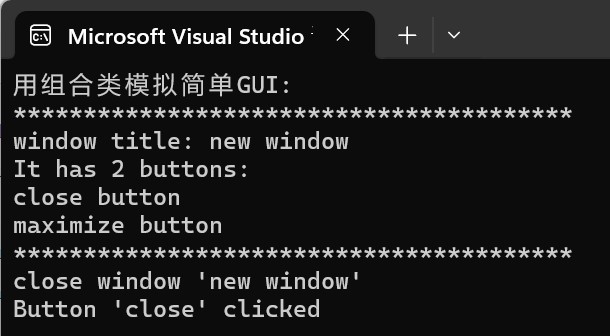
问题1:定义了botton和window类,使用了标准库的string和vector类,button类中使用了string类,window类中使用了botton类和vector类
问题2:不适合 有的是构造函数 有的是输出函数有变量 但是在输出类型void后加const 不会影响值的输出
问题3:输出*号将display输出的内容与其他内容隔断开
试验任务2:
#include <iostream> #include<vector> using namespace std; void output1(const vector<int>& v) { for (auto &i : v) cout << i << ", "; cout << "\b\b \n"; } void output2(const vector<vector<int>> v) { for (auto& i : v) { for (auto& j : i) cout << j << ", "; cout << "\b\b \n"; } } void test1() { vector<int>v1(5, 42); const vector<int>v2(v1); v1.at(0) = -999; cout << "v1:"; output1(v1); cout << "v2:"; output1(v2); cout << "v1.at(0)=" << v1.at(0) << endl; cout << "v2.at(0)=" << v2.at(0) << endl; } void test2() { vector<vector<int>>v1{ {1,2,3},{4,5,6,7} }; const vector<vector<int>>v2(v1); v1.at(0). push_back(-999); cout << "v1: \n"; output2(v1); cout << "v2: \n"; output2(v2); vector<int>t1 = v1.at(0); cout << t1.at(t1.size() - 1) << endl; const vector <int>t2 = v2.at(0); cout << t2.at(t2.size() - 1) << endl; } int main() { cout << "测试1:\n"; test1(); cout << "\n测试2:\n"; test2(); }
运行结果截图:
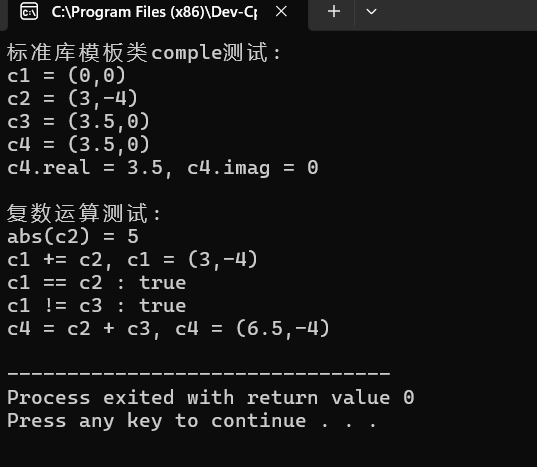
问题1:第一行:初始化v1为5个42 第二行:v2复制v1 第三行:将v1的第一个42改成-999
问题2:第一行:初始化v1 相当于二维数组 第二行:v2为常量复制v1 第三行:将v1第一行中的最后一个改成-999
问题3:t1,t2分别赋值为v1,v2的第一行元素,输出这一行最后一个元素
问题4:深复制,有const接口
实验任务3:
vectorInt.hpp:
#pragma once #include<iostream> #include<cassert> using std::cout; using std::endl; //动态int数组对象类 class vectorInt { public: vectorInt(int n); vectorInt(int n, int value); vectorInt(const vectorInt& vi); ~vectorInt(); int& at(int index); const int& at(int index)const; vectorInt& assign(const vectorInt& v); int get_size()const; private: int size; int* ptr; }; vectorInt::vectorInt(int n) :size{ n }, ptr{ new int[size] } { } vectorInt::vectorInt(int n, int value) :size{ n }, ptr{ new int[size] } { for (auto i = 0; i < size; ++i) ptr[i] = value; } vectorInt::vectorInt(const vectorInt& vi) :size{ vi.size }, ptr{ new int[size] }{ for (auto i = 0; i < size; ++i) ptr[i] = vi.ptr[i]; } vectorInt::~vectorInt() { delete[]ptr; } const int& vectorInt::at(int index)const { assert(index >= 0 && index < size); return ptr[index]; } int& vectorInt::at(int index) { assert(index >= 0 && index < size); return ptr[index]; } vectorInt& vectorInt::assign(const vectorInt& v) { delete[] ptr; size = v.size; ptr = new int[size]; for (int i = 0; i < size; ++i) ptr[i] = v.ptr[i]; return *this; } int vectorInt::get_size()const { return size; }
task3.cpp:
#include "vectorInt.hpp" #include<iostream> using std::cout; using std::cin; void output(const vectorInt& vi) { for (auto i = 0; i < vi.get_size(); ++i) cout << vi.at(i) << ", "; cout << "\b\b \n"; } void test1() { int n; cout << "Enter n:"; cin >> n; vectorInt x1(n); for (auto i = 0; i < n; ++i) x1.at(i) = i * i; cout << "x1:"; output(x1); vectorInt x2(n, 42); vectorInt x3(x2); x2.at(0) = -999; cout << "x2:"; output(x2); cout << "x3:"; output(x3); } void test2() { const vectorInt x(5, 42); vectorInt y(10, 0); cout << "y:"; output(y); y.assign(x); cout << "y:"; output(y); cout << "x.at(0)=" << x.at(0) << endl; cout << "y.at(0)=" << y.at(0) << endl; } int main() { cout << "测试1:\n"; test1(); cout << "\n测试2:\n"; test2(); }
运行结果截图:
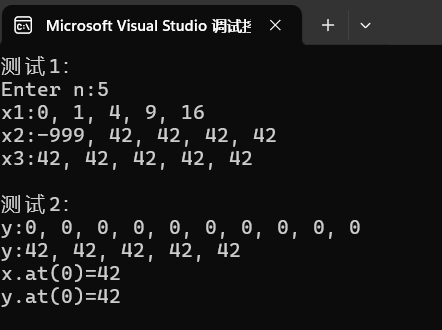
问题1:深复制
问题2:不能正常运行,报错:左操作数必须为左值;删除const后,运行结果正确
问题3:代码能够运行。这样创建新vectorInt型需要额外空间
试验任务4:
matrix.hpp:
#pragma once #include<iostream> #include<cassert> using std::cout; using std::endl; //类Matrix的声明 class Matrix { public: Matrix(int n, int m);//构造函数,构造一个n*m的矩阵,初始值为 value Matrix(int n);//构造函数,构造一个n*n的矩阵,初始值为 value Matrix(const Matrix& x);//复制构造函数,使用已有的矩阵x构造 ~Matrix(); void set(const double* pvalue);//用pvalue指向的连续内存块数据按行为矩阵赋值 void clear();//把矩阵对象的值置0 const double& at(int i, int j)const;//返回矩阵对象索引(i,j)的元素const double& at(int i, int j); int get_lines()const;//返回矩阵对象行数 int get_cols()const;//返回矩阵对象列数 void display()const;//按行显示矩阵对象元素值 private: int lines;//矩阵对象内元素行数 int cols;//矩阵对象内元素列数 double* ptr; }; Matrix::Matrix(int n, int m) :lines(n), cols(m) { ptr = new double[n * m]; for (int i = 0; i < n * m; ++i) { ptr[i] = 0.0; } } Matrix::Matrix(int n) :Matrix(n, n) {} Matrix::Matrix(const Matrix& x) :lines(x.lines), cols(x.cols) { ptr = new double[lines * cols]; for (int i = 0; i < lines * cols; ++i) { ptr[i] = x.ptr[i]; } } Matrix::~Matrix() { delete[] ptr; } void Matrix::set(const double* pvalue) { for (int i = 0; i < lines * cols; ++i) { ptr[i] = pvalue[i]; } } void Matrix::clear() { for (int i = 0; i < lines * cols; ++i) { ptr[i] = 0.0; } } const double& Matrix::at(int i, int j)const { assert(i >= 0 && i < lines && j >= 0 && j < cols); return ptr[i * cols + j]; } double& Matrix::at(int i, int j) { assert(i >= 0 && i < lines && j >= 0 && j < cols); return ptr[i * cols + j]; } int Matrix::get_lines()const { return lines; } int Matrix::get_cols()const { return cols; } void Matrix::display()const { for (int i = 0; i < lines; ++i) { for (int j = 0; j < cols; ++j) { cout << at(i, j) << " "; } cout << endl; } }
task4.cpp:
#include "matrix.hpp" #include <iostream> #include <cassert> using std::cin; using std::cout; using std::endl; const int N = 1000; // 输出矩阵对象索引为index所在行的所有元素 void output(const Matrix& m, int index) { assert(index >= 0 && index < m.get_lines()); for (auto j = 0; j < m.get_cols(); ++j) cout << m.at(index, j) << ", "; cout << "\b\b \n"; } void test1() { double x[1000] = { 1, 2, 3, 4, 5, 6, 7, 8, 9 }; int n, m; cout << "Enter n and m: "; cin >> n >> m; Matrix m1(n, m); // 创建矩阵对象m1, 大小n×m m1.set(x); // 用一维数组x的值按行为矩阵m1赋值 Matrix m2(m, n); // 创建矩阵对象m1, 大小m×n m2.set(x); // 用一维数组x的值按行为矩阵m1赋值 Matrix m3(2); // 创建一个2×2矩阵对象 m3.set(x); // 用一维数组x的值按行为矩阵m4赋值 cout << "矩阵对象m1: \n"; m1.display(); cout << endl; cout << "矩阵对象m2: \n"; m2.display(); cout << endl; cout << "矩阵对象m3: \n"; m3.display(); cout << endl; } void test2() { Matrix m1(2, 3); m1.clear(); const Matrix m2(m1); m1.at(0, 0) = -999; cout << "m1.at(0, 0) = " << m1.at(0, 0) << endl; cout << "m2.at(0, 0) = " << m2.at(0, 0) << endl; cout << "矩阵对象m1第0行: "; output(m1, 0); cout << "矩阵对象m2第0行: "; output(m2, 0); } int main() { cout << "测试1: \n"; test1(); cout << "测试2: \n"; test2(); }
运行结果截图:
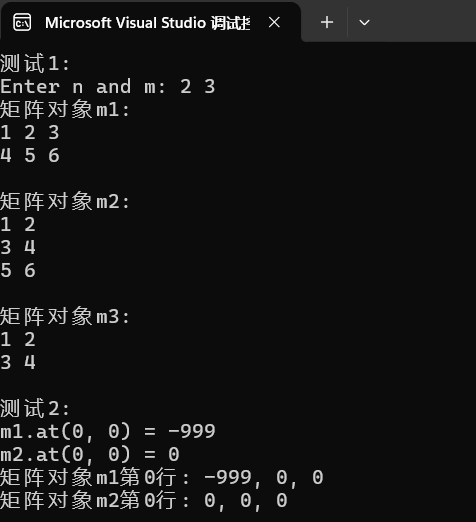
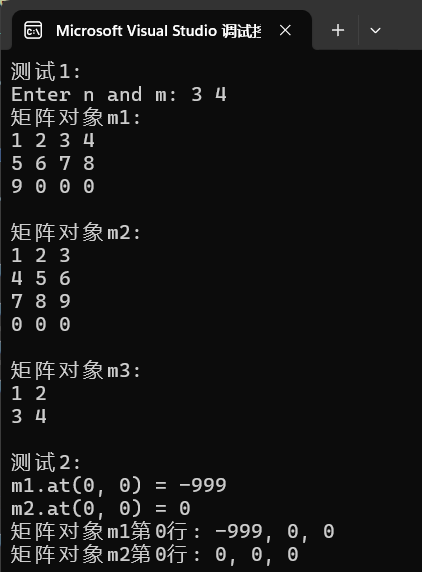
实验任务5:
user.hpp
#pragma once #include <iostream> #include <string> class User { public: User(const std::string& username, const std::string& password = "", const std::string& email = ""); void set_email(); void change_password(); void display() const; private: std::string username_; std::string password_; std::string email_; }; // 构造函数实现 User::User(const std::string& username, const std::string& password, const std::string& email) : username_(username), password_(password), email_(email) {} void User::set_email() { std::string input_email; bool has_at_symbol = false; do { std::cout << "Enter email for " << username_ << ": "; std::cin >> input_email; for (char c : input_email) { if (c == '@') { has_at_symbol = true; break; } } if (!has_at_symbol) { std::cout << "无效的邮箱" << std::endl; } } while (!has_at_symbol); email_ = input_email; } void User::change_password() { std::string old_password; int attempts = 0; while (attempts < 3) { std::cout << "输入旧密码: " << username_ << ": "; std::cin >> old_password; if (old_password == password_) { std::string new_password; std::cout << "输入新密码: " << username_ << ": "; std::cin >> new_password; password_ = new_password; break; } else { attempts++; std::cout << "旧密码错误 " << 3 - attempts << std::endl; } } if (attempts == 3) { std::cout << "错误多次,稍后再试" << std::endl; } } void User::display() const { std::string password_display(password_.length(), '*'); std::cout << "Username: " << username_ << ", Password: " << password_display << ", Email: " << email_; }
task5.cpp
#include "user.hpp" #include <iostream> #include <vector> #include <string> using std::cin; using std::cout; using std::endl; using std::vector; using std::string; void test() { vector<User> user_lst; User u1("Alice", "2024113", "Alice@hotmail.com"); user_lst.push_back(u1); cout << endl; User u2("Bob"); u2.set_email(); u2.change_password(); user_lst.push_back(u2); cout << endl; User u3("Hellen"); u3.set_email(); u3.change_password(); user_lst.push_back(u3); cout << endl; cout << "There are " << user_lst.size() << " users. they are: " << endl; for (auto& i : user_lst) { i.display(); cout << endl; } } int main() { test(); }
运行结果截图:

试验任务6:
account.h:
//account.h #ifndef __ACCOUNT_H__ #define __ACCOUNT_H__ #include "date.h" #include <string> class SavingsAccount {//储蓄账户类 private: std::string id;//账号 double balance;//余额 double rate;//存款的年利率 Date lastDate;//上次变更余额的时期 double accumulation;//按日累加以和 static double total;//所有账户的总金额 //记录一笔账,date为日期,amount为金额,desc为说明 void record(const Date & date, double amount, const std::string & desc); //报告错误信息 void error(const std::string & msg) const; //获得指定日期为止的存款金额按日累增值 double accumulate(const Date & date) const { return accumulation + balance * date.distance(lastDate); } public: //构造函数 SavingsAccount(const Date & date, const std::string & id, double rate);//获得账号 const std::string & getId() const { return id; } //获得余额 double getBalance() const { return balance; } //获得年利率 double getRate() const { return rate; } static double getTotal() { return total; }//存入现金 void deposit(const Date & date, double amount, const std::string & desc);//取出现金 void withdraw(const Date & date, double amount, const std::string & desc);//结算利息,每年1月1日调用一次该函数 void settle(const Date & date); //显示账户信息 void show() const; }; #endif //__ACCOUNT_H__#pragma once
date.h:
//date.h #ifndef __DATE_H__ #define __DATE_H__ class Date {//日期类 private: int year; //年 int month;//月 int day;//日 int totalDays;//该日期是从公元元年1月1日开始的第几天 public: Date(int year, int month, int day);//用年、月、日构造日期 int getYear() const { return year; } int getMonth() const { return month; } int getDay() const { return day; } int getMaxDay() const;//获得当月有多少天 bool isLeapYear() const {//判断当年是否为闰年 return year % 4 == 0 && year % 100 != 0 || year % 400 == 0; } void show() const;//输出当前日期 int distance(const Date & date) const { return totalDays - date.totalDays; } }; #endif //__DATE_H__
account.cpp:
//account.cpp #include "account.h" #include <cmath> #include <iostream> using namespace std; double SavingsAccount::total = 0; //SavingsAccount类相关成员函数的实现 SavingsAccount::SavingsAccount(const Date &date,const string &id,double rate):id(id),balance(0),rate(rate),lastDate(date),accumulation(0){ date.show(); cout << "\t#" << id << " created" << endl; } void SavingsAccount::record(const Date & date, double amount, const string & desc) { accumulation = accumulate(date); lastDate = date; amount = floor(amount * 100 + 0.5) / 100; //保留小数点后两位 balance += amount; total += amount; date.show(); cout << "\t#" << id << "\t" << amount << "\t" << balance << "\t" << desc << endl; } void SavingsAccount::error(const string & msg) const { cout << "Error(#" << id << "): " << msg << endl; } void SavingsAccount::deposit(const Date & date, double amount, const string & desc) { record(date, amount, desc); } void SavingsAccount::withdraw(const Date & date, double amount, const string & desc) { if (amount > getBalance()) error("not enough money"); else record(date, -amount, desc); } void SavingsAccount::settle(const Date & date) { double interest = accumulate(date) * rate / date.distance(Date(date.getYear() - 1, 1, 1)); if (interest != 0) record(date, interest, "interest"); accumulation = 0; } void SavingsAccount::show() const { cout << "ID: " << id << "\tBalance: " << balance; }
date.cpp:
//date.cpp #include "date.h" #include <iostream> #include <cstdlib> using namespace std; namespace { //namespace使下面的定义只在当前文件中有效 const int DAYS_BEFORE_MONTH[] = { 0, 31, 59, 90, 120, 151, 181, 212, 243, 273, 304, 334, 356 }; } Date::Date(int year, int month, int day) :year(year), month(month), day(day) { if (day <= 0 || day > getMaxDay()) { cout << "Invalid date: "; show(); cout << endl; exit(1); } int years = year - 1; totalDays = years * 365 + years / 4 - years / 100 + years / 400 + DAYS_BEFORE_MONTH[month - 1] + day; if (isLeapYear() && month > 2) totalDays++; } int Date::getMaxDay() const { if (isLeapYear() && month == 2) return 29; else return DAYS_BEFORE_MONTH[month] - DAYS_BEFORE_MONTH[month - 1]; } void Date::show() const { cout << getYear() << "-" << getMonth() << "-" << getDay(); }
task6.cpp:
//6.25.cpp #include "account.h" #include <iostream> using namespace std; int main() { Date date(2008, 11, 1); //起始日期 //建立几个账户 SavingsAccount accounts[] = { SavingsAccount(date, "03755217", 0.015), SavingsAccount(date, "02342342", 0.015) }; //几笔账目 accounts[0].deposit(Date(2008, 11, 5), 5000, "salary"); accounts[1].deposit(Date(2008, 11, 25), 10000, "sell stock 0323"); accounts[0].deposit(Date(2008, 12, 5), 5500, "salary"); accounts[1].withdraw(Date(2008, 12, 20), 4000, "buy a laptop"); //结算所有账户并输出各个账户信息 cout << endl; for (int i = 0; i < sizeof(accounts) / sizeof(SavingsAccount); i++) { accounts[i].settle(Date(2009, 1, 1)); accounts[i].show(); cout << endl; } cout << "Total: " << SavingsAccount::getTotal() << endl; return 0; }





【推荐】国内首个AI IDE,深度理解中文开发场景,立即下载体验Trae
【推荐】编程新体验,更懂你的AI,立即体验豆包MarsCode编程助手
【推荐】抖音旗下AI助手豆包,你的智能百科全书,全免费不限次数
【推荐】轻量又高性能的 SSH 工具 IShell:AI 加持,快人一步
· 被坑几百块钱后,我竟然真的恢复了删除的微信聊天记录!
· 【自荐】一款简洁、开源的在线白板工具 Drawnix
· 没有Manus邀请码?试试免邀请码的MGX或者开源的OpenManus吧
· 园子的第一款AI主题卫衣上架——"HELLO! HOW CAN I ASSIST YOU TODAY
· 无需6万激活码!GitHub神秘组织3小时极速复刻Manus,手把手教你使用OpenManus搭建本